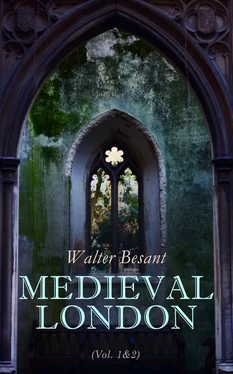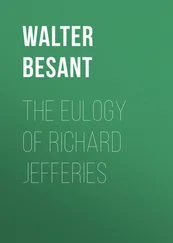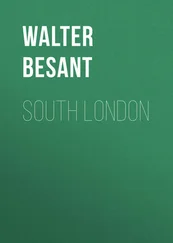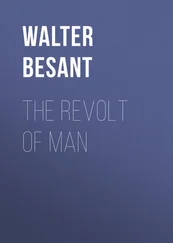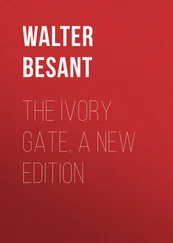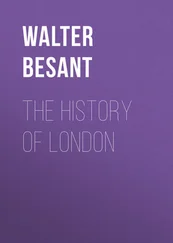In the year 1236 the City received the new Queen with every outward sign of welcome, and, unfortunately for themselves, of wealth. What was Eleanor of Provence, what was the young King, to think of the resources of the city which could receive them with so brave a show? Thus writes Stow concerning this Riding:—
“The cittie was adorned with silkes, and in the night with lampes, cressets, and other lights without number, besides many pageants and strange devices which were shewed. The citizens rode to meete the king and queene, beeing clothed in long garmentes embrodered about with golde and silke of divers colours, their horses finely trapped in arraie to the number of three hundred and sixty, every man bearing golden or silver cuppes in their hands, and the king’s trumpeters before them sounding. The citizens of London did minister wine as butlers.” (Howe’s edition of Stow’s Chronicles, p. 184.)
In the year 1236 water was first brought into the City by pipes from the Tyburn, or from wells or springs in the district called Tyburn, now Marylebone. These pipes were of lead and discharged the water into cisterns which were afterwards castellated with stone. The most important of them was that in Chepe: there were in all, when other pipes had been laid down, nineteen conduits: and it became the custom, once a year, for the Mayor and Aldermen to ride out in order to inspect the Heads from which the conduits were supplied, after which they were wont to hunt a hare before dinner and a fox after dinner in the fields about Marylebone.
In the year 1238 a singular procession passed out of St. Paul’s Cathedral along Fleet Street and the Strand as far as Durham House, then the palace of the Legate. The procession consisted of a large body of ecclesiastics, Doctors in Divinity and Law, followed (or preceded) by a company of young men: they were ungirded, without gown, bareheaded and barefooted. There were the Heads of Houses, the Master and Students of the University of Oxford headed by Ado de Kilkenny, Standard Bearer to the scholars: they were on their way to pray the Legate’s pardon for a late lamentable outbreak in Oxford. It began with an Irish undergraduate, who went into the Legate’s kitchen to beg for food. The cook in reply took up a pot filled with hot broth and threw it in his face. A Welsh student, also come on the same errand, was so exasperated at the sight of the outrage that he killed the cook, there and then. After which the students rose in a body and attacked the house. The Legate fled for his life, taking refuge in a church steeple whence he escaped under cover of the night. As soon as he was safe he interdicted the University, and excommunicated all concerned in the riot. But on their submission he granted his forgiveness and removed the Interdict.
In 1250 the King sent for the principal citizens, and assured them that he would no longer oppress them by taxation. This promise was never meant to be kept. On a frivolous complaint of Richard, the King’s brother, the City liberties were seized and a custos appointed, who remained in office until the City had paid a fine of six hundred marks. Five hundred more were demanded for a new charter by which the incoming Mayor might be presented to the Barons of the Exchequer every year instead of the King. The old jealousy with which the citizens looked upon the Tower was about this time revived and strengthened by the erection of a wall round the Tower. Longchamp had made the ditch, but his work remained incomplete. Henry resolved to carry it on and to make an independent fortress surrounded by its own walls and having its own communications with the river and the country outside. The citizens looked upon the rise of this wall with suspicion and misgiving. Before the work was completed the wall fell down. It was put up again, and again it fell down, to the great joy of the people, who looked upon it as a direct intervention of Heaven on their behalf. That this was really the case was proved by a story which ran about the City that the overthrow of the wall was done by St. Thomas à Becket himself.
“A vision appeared by night to a certain priest, a wise and holy man, wherein an archprelate, dressed in pontifical robes, and carrying a cross in his hand, came to the walls which the King had at that time built near the Tower of London, and, after regarding them with a scowling look, struck them strongly and violently with the cross, saying, ‘Why do ye rebuild them?’ Whereupon the newly-erected walls suddenly fell to the ground, as if thrown down by an earthquake. The priest, frightened at this sight, said to a clerk who appeared following the archprelate, ‘Who is this archbishop?’ to which the clerk replied, ‘It is St. Thomas the martyr, a Londoner by birth, who considered that these walls were built as an insult, and to the prejudice of the Londoners, and has therefore irreparably destroyed them.’ The priest then said, ‘What expense and builders’ labour have they not cost.’ The clerk replied,‘If poor artificers, who seek after and have need of pay, had obtained food for themselves by the work, that would be endurable; but inasmuch as they have been built, not for the defence of the kingdom, but only to oppress harmless citizens, if St. Thomas had not destroyed them, St. Edmund the Confessor and his successor would still more relentlessly have overthrown them from their foundations.’ The priest, after having seen these things, awoke from his sleep, rose from his bed, and in the dead silence of the night told his vision to all who were in the house. Early in the morning a report spread through the city of London that the walls built round the Tower, on the construction of which the King had expended more than twelve thousand marks, had fallen to pieces, to the wonder of many, who proclaimed it a bad omen, because the year before, on the same night, which was that of St. George’s day, and at the same hour of the night, the said walls had fallen down, together with their bastions. The citizens of London, although astonished at this event, were not sorry for it; for these walls were to them as a thorn in their eyes, and they had heard the taunts of the people who said that these walls had been built as an insult to them, and that if any one of them should dare to contend for the liberty of the City, he would be shut up in them, and consigned to imprisonment; and in order that, if several were to be imprisoned, they might be confined in several different prisons, a great number of cells were constructed in them apart from one another, that one person might not have communication with another.” (Matthew Paris.)
The wealth of the Jews—or at least of one Jew—is shown by the exactions of the King from Aaron of York. He made this man—one of “his” Jews—pay him the sum of 14,000 marks for himself and 10,000 marks for the Queen. He had before this made the unfortunate Aaron give him 3000 marks besides 200 marks of gold for the Queen, in all about 60,000 marks or £40,000, which in our money would be equal to about half a million sterling. In 1252 the King seized the half of all the property possessed by the Jews. But there was worse trouble for the Jews than mere plunder. In 1225 the Jews of Norwich were thrown into prison on a charge of circumcising a boy with the intention of crucifying him at Easter. They were accused, convicted, and “punished”—hanged or burned. In 1255 one hundred and forty-three Jews were brought to Westminster charged with crucifying a child named Hugh de Lincoln. Eighteen of them were hanged; the rest were kept in prison a long time. In 1239 they were accused of a murder “secretly committed,” and were glad to escape with the loss of the third part of their property. The Pope’s Nuncio, Stephen, was succeeded by one Martin, who carried on the same exactions, regardless of murmurs and threats. The King was persuaded to hold an inquiry into the number and value of the benefices held by foreigners preferred by the Pope. The annual value was found to be 60,000 marks, or £40,000, an enormous sum at that time. The detention of a messenger with letters from the Pope to his Nuncio, brought the matter to a head. On an occasion when a large number of lords, knights, and gentlemen met together at Dunstable, they united in sending a message to Martin that he must quit the kingdom. He was then residing in the Temple. The story shows the exasperation of the people and the helplessness of the King, whose authority was thus usurped:—
Читать дальше
